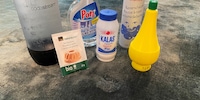

Microplastics: the invisible enemy
Every time we wash our clothes, microplastics end up down the drain. But there are tricks you can use to protect the environment in the long term.
Whether it's sportswear, underwear or fleece jackets, your wardrobe is full of microplastics. These particles, less than five millimetres in size and barely visible to the naked eye, adhere to polymer textiles : These days, virtually no garment can do without synthetic fibres such as polyester, polyamide, nylon, lycra or elastane (commonly known as stretch). The advantage of this type of fabric? Its ease of care and (unfortunately) its ridiculously low price.
In the washing machine, however, synthetic fibres pose a problem. With each cycle, microplastics break away from these fabric fibres. Sewage treatment plants are unable to filter these particles, which end up with the wastewater in lakes and seas, where they contaminate flora and fauna. Microplastics also find their way into the food chain. Researchers at the University of Newcastle in Australia suspect that we consume up to five grams of microplastic per week, an amount equivalent to about a level teaspoon of table salt.
According to Greenpeace, more than a third of all microplastic particles in the world's oceans are attributable to synthetic clothing. With these tips, you can make a small but effective contribution to protecting the environment, at least when it comes to washing. A must if you want to consume less plastic.
Before washing
Wise shopping
Before microplastics end up in the pipes, you need to avoid synthetic fibres such as elastane, acrylic and polyester. According to Greenpeace, 60% of our clothes are made from polyester. The University of Plymouth in England has studied how many plastic particles a polymer textile releases into the water per 30-40°C wash cycle. In the case of a blended fabric (made up of polyester and cotton), around 138,000 are released from the synthetic fibres, in the case of polyester, 496,000, and acrylic, 729,000.
Mixed fabrics can also contain polymer fibres. The next time you make a purchase, take a look at the label! Choose natural fibres such as linen, wool, merino, cashmere, silk and hemp! Cotton is also one of these, but as its cultivation is anything but sustainable and huge quantities of water are used to grow it, it is the subject of criticism from sustainable consumers.
Don't get rid of all your previously purchased polymer textiles now! Keep them instead of replacing them with new clothes, otherwise you'll be harming the environment too! Another tip is to wash them less often (see below)!
Detergent
Both synthetic fibres and detergents contain tiny plastic compounds that remove dirt particularly effectively. Instead, use liquid biodegradable detergents, while the powder contains abrasive particles that break the fibres even more. However, there are alternatives such as wash balls, which replace detergent with negative ions. However, their mode of action has not been scientifically proven. And what's more, they're also made of plastic.

During the wash
The adage goes that you shouldn't put off until tomorrow what you can do the same day. However, there are exceptions. Washing your clothes on Monday, but the laundry basket is still half empty for once? Wait until it's full before you start! A half-filled drum encourages friction between clothes. The result? More fibres are released. The same problem arises if the spin cycle is too fast: in this case, you need to reduce the number of revolutions per minute.
Changing programmes
Did you know that of all the programmes, the gentle wash programme releases the most microplastics? A study from Newcastle University shows that up to 800,000 extra particles are released per wash cycle. The reason? The higher quantity of water, which causes additional fibre breakage. However, it's best to plan a wash cycle at 40°C (maximum) and a short wash programme.
Filter system
Microplastic filters that you connect to your washing machine are utopian. The solution is to use special wash bags in which synthetic fibre clothes are washed. This is designed to retain the microplastics during the cycle.
After washing
From now on, leave your tumble dryer to one side! Hang your clothes to dry instead. The tumble dryer removes moisture from textiles and also dissolves other microplastics, which end up in the water tank during the condensation process. When it is emptied, these particles also end up in the wastewater.
As a general rule, don't clean a garment until it's really dirty! And not after you've worn it once either! Air it out by putting it outside! You can also wash individual stains locally by hand. Only when a garment fails the stain and odour test can you put it in the laundry basket.
When I’m not exploring the depths of the sea as an open water diver, I enjoy plunging into the world of fashion. On the streets of Paris, Milan and New York is where I keep my eyes peeled for the latest trends. And I’ll show you how to take them from the catwalk to your everyday life.
Practical solutions for everyday problems with technology, household hacks and much more.
Show all


